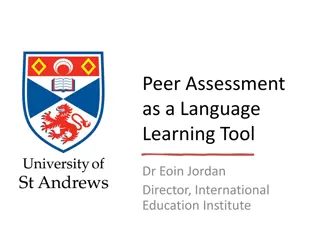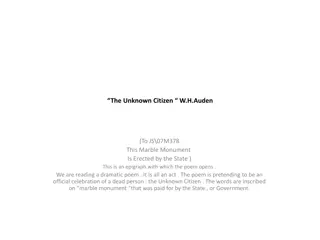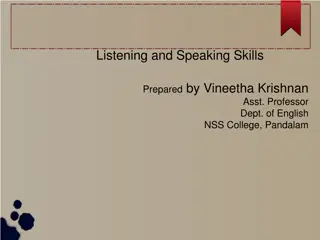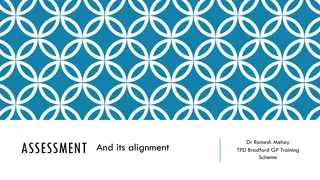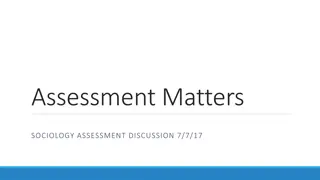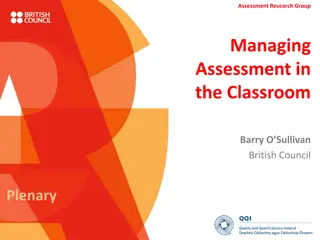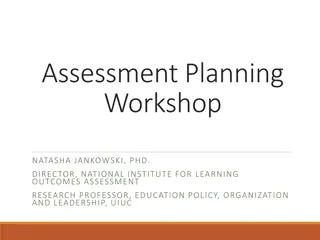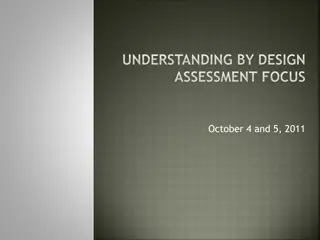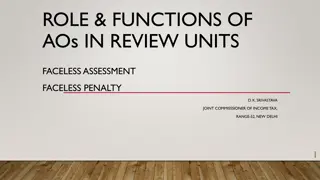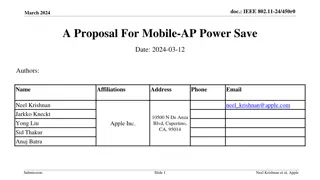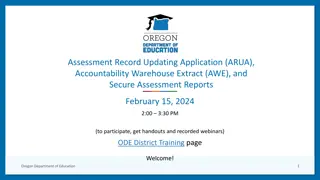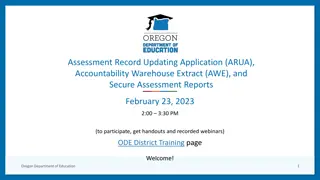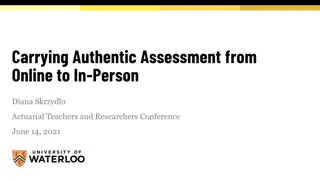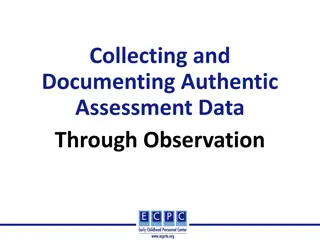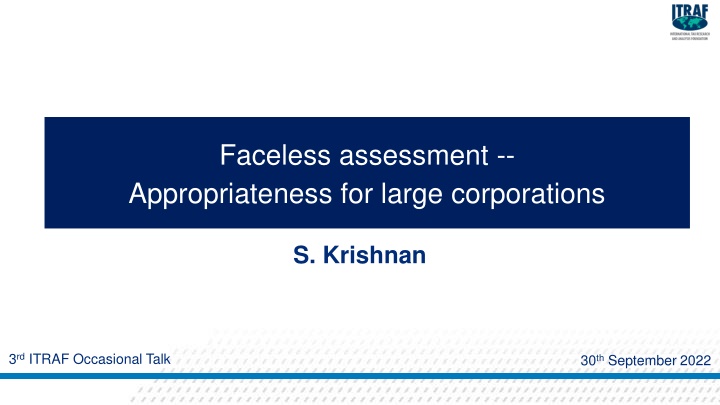
Transforming Taxation: Faceless Assessment for Fairness
Explore the Faceless Assessment scheme launched by India's Prime Minister Narendra Modi, which revolutionizes the tax assessment process for large corporations. This innovative approach ensures transparency, fairness, and efficiency by removing individual jurisdiction, introducing team-based assessments, and enabling electronic responses. Discover how this system enhances taxpayer experience and eliminates harassment.
Download Presentation

Please find below an Image/Link to download the presentation.
The content on the website is provided AS IS for your information and personal use only. It may not be sold, licensed, or shared on other websites without obtaining consent from the author. If you encounter any issues during the download, it is possible that the publisher has removed the file from their server.
You are allowed to download the files provided on this website for personal or commercial use, subject to the condition that they are used lawfully. All files are the property of their respective owners.
The content on the website is provided AS IS for your information and personal use only. It may not be sold, licensed, or shared on other websites without obtaining consent from the author.
E N D
Presentation Transcript
Faceless assessment -- Appropriateness for large corporations S. Krishnan 3rd ITRAF Occasional Talk 30th September 2022
Faceless assessment - I India s Prime Minister, Mr. Narendra Modi launched a platform for Transparent Taxation Honouring the Honest on 13th Aug 2020 comprising of 3 reforms - Faceless assessment, Faceless appeals and the Taxpayers Charter The faceless assessment scheme significantly changes the manner of assessment in India and the functioning of the Income-tax department Primarily, an Assessing Officer (AO) will no more have any jurisdiction over any taxpayer, so much so that the identity of the taxpayer is not even disclosed to an AO (hence faceless). Instead, the National Faceless Assessment Centre (NaFAC) will be the focal point of the faceless assessment procedure and the sole point of interaction with the taxpayer Secondly, the assessment procedure is converted to a team-based assessment from an individual driven activity in the past. Multiple units such as assessment unit, verification unit, technical unit and review unit are involved in the faceless assessment procedure. This brings in functional specialisation, optimises the use of resources and eliminates the scope for arbitrariness by an AO Through these changes, high-pitched assessments and taxpayer harassment could be eliminated
Faceless assessment - I The faceless assessment scheme removes the power of the AO to issue assessment orders at a local jurisdictional level. Consequently, AOs will not have an opportunity to issue a favourable order to a tax payer in return for a pecuniary payment The faceless assessment procedure involves multiple layers of evaluation by different units. The assessment unit can only make a draft assessment order and send it to the NaFAC, which will examine it according to the risk management strategy specified by the Central Board of Direct Taxes (CBDT). NaFAC may assign the draft assessment order to a review unit in any other Regional Faceless Assessment Centre (ReFAC) through an automated allocation system, for a review of the same The NaFAC shall provide an opportunity to the assessee to respond in case a modification prejudicial to the interest of the assessee is proposed in the draft / revised draft / final draft assessment order If a modification is proposed in the draft assessment order, the taxpayer or his authorised representative can only request for personal hearing to make their submissions. This request may be granted at the discretion of the head of the ReFAC. If the request is granted, such hearing shall be conducted exclusively through video conferencing or video telephony
Faceless assessment - I The taxpayer should respond to notices electronically, without the need to visit a tax office or meet any official. This, the PM said, will end the era of jaan pehchan (acquaintance) to get scrutiny or notices settled At the launch of the faceless assessment scheme, the PM said the tax system may be turning faceless but it promises fairness and fearlessness for taxpayers and assured that the focus was on making the tax system people-centric and public-friendly rather than power centric He remarked that an attempt has been made to make the tax system seamless, painless, and faceless. While seamless means tax administration does not complicate, painless means simple rules and use of technology
Time limit to respond to notices Questions asked to the CBDT after the launch of faceless assessment scheme: Faceless Assessment Scheme provides that a taxpayer shall be required to file his response to the NaFAC within 15 days from the date of receipt of the notice. It needs to be clarified that such a period shall be granted for submission of responses to all subsequent notices as well Dept officials assured that, in any case, the taxpayer shall be given not less than 15 days to respond to all notices issued by NaFAC Where a taxpayer is prevented by a reasonable cause for timely compliance of a Notice from NaFAC and requests for further time, whether suitable accommodation of time may be permitted? The officials assured that the dept will provide sufficient time to the taxpayer to respond to notices. It will take recourse to section 144 proceedings only in a very rare situation. The new functionality will be brought in to allow the taxpayer to seek adjournment where they have been prevented by reasonable cause to submit their response well within the allowed time The NaFAC is required to provide an opportunity to the assessee to respond in case a modification prejudicial to the interest of the assessee is proposed in the draft / revised draft / final draft assessment order
Litigation in faceless assessment - I Taxpayers have filed numerous writ petitions before courts on the ground of violation of the principles of natural justice and sought quashing of assessment orders and consequent tax demands raised on them. Some of the reasons are described below Reasonable time to file response to the draft assessment order was not granted Parag Kishorchandra Shah Vs The National Faceless Assessment Centre & Others. (Bombay High Court writ petition) Assessee was granted only one working day to respond to the Draft Assessment Order and even the response and documents filed earlier by the assessee were not considered in the Draft Assessment Order Bombay High Court quashed faceless assessment order for granting less than 24 working hours to respond to the Draft Assessment Order, directs the Assessing Officer to pay Rs. 25,000 as donation to PM Cares fund from his/her personal account Remarks, this is a fit case where a direction needs to be issued to the Assessing Officer to pay costs to bring judicious approach amongst Assessing Officers for effective implementation of faceless assessment in its letter and spirit. Undue haste in passing order of assessment runs counter to the purpose behind introduction of Faceless Assessment Scheme resulting in over-burdening of the Courts Contd..
Litigation in faceless assessment - I The faceless assessment scheme permits an assessee to seek adjournment / extension of time limit from the NaFAC to file responses. Such requests were not considered in some instances before passing of assessment orders Assessment order passed without considering assessee s request for adjournment KBB Nuts (P.) Ltd. v. National Faceless Assessment Centre, Delhi High Court - A show cause notice along with the draft assessment order dated 19.04.2021, were served on the assessee asking it to file its response by 23:59 hours on 21.04.2021 (within 2 days!!). Since the time for compliance was short, the assessee filed an application via the e-portal, seeking a day s adjournment, i.e., till 22.04.2021. The objections to the aforementioned SCN were filed on 22.04.2021 at 15.22 hours. However, the AO passed the impugned assessment order on 22.04.2021. The Delhi HC set aside the order and directed the AO to grant fresh opportunity Sudhir Desh Ahuja v. NaFAC The assessee requested for adjournment on the ground that his son and wife have been admitted to hospital and it is difficult to collate necessary information. The AO failed to deal with assessee s request for granting adjournment. Therefore, impugned assessment order passed by revenue as well as notices for initiating penalty proceedings were set aside Contd..
Litigation in faceless assessment - I Final Assessment Order passed before lapse of time given in Show Cause Notice Renew Power Pvt Ltd v National e-Assessment Centre, Delhi High Court writ petition The AO passed the assessment order before completion of time given in show cause notice (SCN). The HC set aside the order as the same was passed much before the time to file the response elapsed With respect to Revenue s argument that an alternate statutory remedy is available to the petitioner, the HC held that alternate remedy is simply a self-imposed limitation which does not prevent a Court from entertaining a writ petition in a fit case The HC also rejected Revenue s contention that several opportunities were given to the petitioner, before issuing the SCN-cum-draft assessment order and therefore there was no violation of principles of natural justice The HC held as follows: Notices issued prior to this stage are inquisitorial in nature. These are issued to ferret information and make inquiries with the object to, inter alia, ensure that there is no understatement of income or a claim of excessive loss, or a case involving under payment of tax; but once a SCN-cum-draft assessment order is issued, the noticee s statutory right to file a reply and seek a personal hearing kicks in, which cannot be curtailed
Importance of technology infrastructure Success of the faceless assessment scheme largely depends on the ability of the CBDT to establish appropriate information technology infrastructure to process assessments of a large number, support big data submissions and to archive the assessment documents of all the taxpayers over a period of time The Income-tax dept has set a limit to the size of taxpayer response to notices under e- proceeding. The response should be provided in less than 4,000 characters in Response/ Remarks field. The maximum file size of one attachment is 5MB and the maximum number of attachments which can be uploaded in response to one partial response is 10 In the case of large corporate taxpayers, back-up documents for certain transactions may run into several hundred pages. Consequently, such taxpayers may be compelled to provide an incomplete/ inappropriate response due to size limitations, leading to a potential improper assessment Many companies may not have the required IT infrastructure to submit large volume of data. In addition, it would be difficult for them to provide large volume of data to the Income-tax department if limits are imposed on the technology infrastructure to transfer data Contd..
Importance of technology infrastructure Questions asked to the CBDT after the launch of faceless assessment scheme: The e-filing website does not permit a taxpayer to upload more than 10 attachments, not exceeding 10 Mb each. Is Dept. considering the possibility to cure this defect? Officials from income tax dept assured that the Dept. will enhance the capabilities to accept responses by the taxpayer. It was categorically assured that the dept will make sure that pointed and relevant questions only are asked from the taxpayer. They also said that if taxpayers provide focused replies, then these limits should be more than enough to capture the information asked in notices Contrary to the above, some corporate taxpayers have received notices seeking voluminous details not justified by the facts of the case. For instance, companies whose accounts are audited have been asked to provide copies of all bank statements, sometimes with summaries of transactions, and sometimes with the narration of each transaction!! For most small and mid-sized companies, this is a difficult and time-consuming task Limited/private limited companies having turnover of more than Rs. 100 crores are asked to submit ledger/PAN/addresses of all parties relating to all expenses (including direct expenses) along with proof of genuineness of such expenditure Contd..
Importance of technology infrastructure Companies having huge turnover are asked to submit complete details of product sales, name, address, PAN etc., of all purchasers, date of receipt of payment, and all evidences The time given to taxpayers to provide the information should be commensurate to the amount of information sought. A large number of documents were sought, requiring the taxpayer to spend plenty of time in scanning documents and uploading them in multiple batches, considering the capacity constraints for uploading data on the portal. Many companies were unable to respond in time due to constraints caused by lockdowns and non- availability of staff Delhi High Court set aside some high pitch faceless assessments on the ground of violation of principles of natural justice: a. Assessee could not respond due to technical glitches on the IT portal and insufficient time was provided by the AO. HC held that the assessment order passed is in violation of principles of natural justice b. The petitioner could not request for personal hearing on the e-portal due to technical glitches but requested for the same in writing. The HC set aside the assessment stating that the petitioner cannot be said to have not opted for personal hearing
Faceless assessment for companies The faceless assessment may be inappropriate for corporate taxpayers a. The anonymity associated with faceless assessment is unsuitable for corporate taxpayers. The faceless assessment scheme does not envisage a discussion before an assessment is concluded and thus does not provide an opportunity for the tax officials to understand the taxpayer s business model The Madras High Court while reviewing a writ petition in February 2020 made the following observation, The Government of India has introduced E-Governance for the conduct of assessment proceedings electronically. It is a laudable step taken by the ITD to pave way for an objective faceless E-assessment without human interaction. At the same time, such proceedings can lead to erroneous assessment if officers are not able to understand the transactions and statements of accounts of an assessee without a personal hearing. b. In many instances, taxpayers may not be able to convey their responses appropriately in a written form. A discussion in such circumstances may be apt c. The technology infrastructure is grossly inadequate for data submission by corporates
Faceless assessment for companies The faceless assessment may be inappropriate for corporate taxpayers d. Taxpayers can request for a personal hearing only in limited circumstances, which may or may not be granted by the tax officials. In such circumstances, corporate taxpayers may not have an opportunity to explain (in person) business-related complexities and various positions they have taken while filing their income-tax returns which was possible under the earlier face-to-face interactions
Appropriate assessment for companies A remote online discussion-based assessment and an online evaluation of data by information technology specialists from technical units would be more appropriate than faceless assessment for companies A video recording of the entire remote discussion may prevent taxpayer harassment
Shortcomings in Faceless Assessment - I NaFAC has identified 9 commonly occurring procedural lapses in faceless assessment proceedings based on an analysis of writ petitions filed in various courts against faceless assessments between April to December 2021 i. Assessment order has been passed even before the due date for reply allowed in the show cause notice / draft assessment order ii. Order has been passed without serving a draft assessment order / show cause notice iii. Order has been passed without giving opportunity of personal hearing (video conference) to the assessee iv. Reasonable time has not been allowed to respond to notices v. Order has been passed without taking cognizance of the response uploaded by assessee vi. Order passed beyond scope of scrutiny vii.Order passed without disposing objections / grounds of reopening challenged viii.Order passed before directions issued by Dispute Resolution Panel ix. Order passed without considering adjournment application
Shortcomings in faceless assessment - I NaFAC has requested Chief Commissioners of Income-tax (ReFAC) to sensitise the assessment units under their charge so that such lapses are not repeated and the unit heads may also be directed to check upon such issues before approving the final assessment order The commonly occurring procedural lapses identified above clearly indicates an implementation failure of the faceless assessment procedure by NaFAC since the faceless assessment procedure centralises the assessment procedure with NaFAC
Faceless assessment - II The following amendments were made to section 144B (Faceless Assessment) of the Income-tax Act to streamline the process of faceless assessment Modification/elimination of certain functions a. NaFAC was originally vested with the jurisdiction to make faceless assessment Under the amended section 144B, NaFAC is only tasked to facilitate the conduct of faceless assessment proceedings in a centralised manner. It is no more vested with the jurisdiction to make faceless assessment b. The role of Asessment Units (AU) have been significantly enhanced as they are no more required to facilitate but conduct the faceless assessment. For example, the AU shall serve upon an assessee, who has failed to provide further information, documents or evidence sought from such assessee, a notice, through the NaFAC, under section 144, giving him an opportunity to show-cause on a date and time as specified in such notice as to why the assessment in his case should not be completed to the best of its judgment Further, the term AU shall refer to an AO having powers so assigned by the CBDT
Faceless assessment - II Modification/elimination of certain functions c. The amended section 144B does not make any reference to ReFAC. Consequently, one administrative layer has been eliminated and henceforth, NaFAC will facilitate the conduct of faceless assessment proceedings in a centralised manner d. Earlier, NaFAC shall, upon receiving suggestions for variation from the Review Unit (RU), assign the case to an AU, other than the AU which made the draft assessment order, through an automated allocation system Under the amended faceless assessment, NAFAC shall forward the review report to the same AU which had proposed the income or loss determination proposal e. The AU was originally required to consider the variations suggested by the RU and send the final draft assessment order to NaFAC Under the amended section 144B, the AU shall accept or reject some or all of the modifications proposed in the review report and after recording reasons in case of rejection of such modifications, prepare a draft order and send it to NaFAC. The power of the AU is enhanced at the cost of overriding the functions of a RU
Faceless assessment - II Mandatory personal hearing If a taxpayer requests for a personal hearing, the income-tax authority of relevant unit shall allow such hearing, through NaFAC. It shall be conducted exclusively through video conferencing or video telephony Provision for review of draft assessment order Earlier, an assessee was provided multiple opportunities to respond to draft assessment order (DAO) or final DAO or revised DAO in case any variation prejudicial to the interest of assessee is proposed in such orders Under the amended faceless assessment, the assessee is provided only one opportunity to respond to a show-cause notice which states the variations proposed to be made to the income of the assessee. In particular, the assessee is not provided an opportunity to respond to the final assessment order even if the order is prejudicial to the interests of the assessee. This may result in litigation on the grounds of violation of principles of natural justice
Faceless assessment - II Deletion of provisions declaring assessment proceedings as nonest in case of non-observance of prescribed procedure Section 144B provided that a faceless assessment shall be non est (meaning non- existent) if such assessment was not made in accordance with the procedure laid down under this section. Consequently, many courts had set aside the assessment orders passed when the prescribed procedure was not followed such as not granting personal hearing, not serving the draft order and show cause notice, etc. Under the amended section 144B, the said provision is deleted with retrospective effect from April 1, 2021 to save the assessment proceedings from being declared non est due to technical glitches. There would be no recourse to the assessee if arbitrary assessments are issued without following the procedure of section 144B No specific time limit for filing response to notice issued under Section 143(2) Earlier, a taxpayer was provided a timeframe of 15 days to file a response to a notice issued under section 143(2). Under the amended section 144B, a taxpayer is required to file a response to NaFAC within the date specified in the notice
Conclusion The intent of introducing the faceless assessment is laudable considering the circumstances in which it was introduced However, the amendments to the faceless assessment scheme has significantly enhanced the power of an Assessing Officer and diluted the team-based assessment procedure as originally envisaged. The amended faceless assessment has made the tax system more power centric and public unfriendly In the case of large corporate taxpayers, it may be practical to adopt face-to-face assessment through video conferencing (being recorded) instead of faceless assessments


